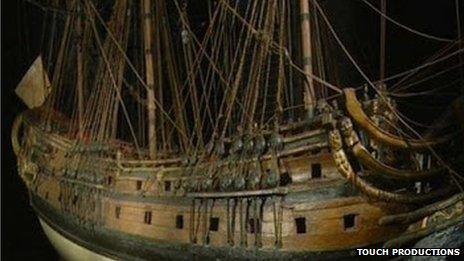Southend's 17th Century shipwreck dive slowed by bad weather
- Published

A CGI reconstruction of the London before it was wrecked
Divers said they were hindered by bad weather as they began the excavation of a 17th Century shipwreck.
English Heritage has begun a two-year exploration of the London, a warship which sank off the Essex coast in 1665.
But high winds last week prevented the archaeologists from exploring the seabed off the coast of Southend-on-Sea for three of the planned six days.
The aim of the excavation is to recover artefacts from the "rapidly deteriorating" wreck.

The artefacts, including this signet pipe tamper ring, will go on display in Southend
English Heritage's marine archaeologist Mark Dunkley said: "We are hoping to recover some rare and well-preserved items which will provide a great insight into the English Navy during an unsettled time when Britain was emerging as a global power."
Test dives have so far recovered personal items such as leather shoes and navigational dividers, buckets, pots and cooking utensils, as well as ship fixtures and fittings.
The London was on its way from Chatham to The Hope, near Gravesend, Kent, when it blew up and sunk.
In 2005, it was rediscovered during works ahead of the London Gateway Port development in Thurrock, Essex.

Test dives have recovered domestic articles such as this pewter pot

This leather shoe was also recovered from the London
It is on English Heritage's at risk register because its fragile remains were being exposed by shifting sediment levels on the seabed.
Archaeologists from Cotswold Archaeology have been commissioned to undertake the excavation.
They are scheduled to dive again in June and July and hope to make up for last week's lost time with a further series of dives in August.
Finds recovered from the site will eventually be put on permanent display by Southend Museums Service.
- Published13 April 2014

- Published18 July 2013
